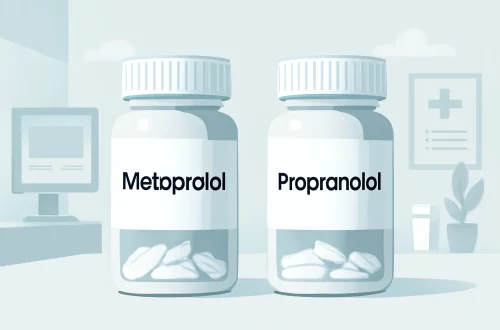
Atomoxetine vs Guanfacine: Which is Better for ADHD Treatment?
Attention-deficit/hyperactivity disorder (ADHD) is a complex neurodevelopmental disorder that affects both children and adults. It is characterized by symptoms such as inattention, hyperactivity, and impulsivity, which can significantly impact daily life and functioning. As awareness of ADHD continues to grow, so does the demand for effective treatment options. While behavioral therapies are often recommended, pharmacological interventions are also frequently utilized. Among these, Atomoxetine and Guanfacine have emerged as two popular non-stimulant medications.
Atomoxetine, a selective norepinephrine reuptake inhibitor, is primarily used in the treatment of ADHD. It works by increasing the levels of norepinephrine in the brain, which helps improve attention and decrease impulsivity and hyperactivity. On the other hand, Guanfacine, an alpha-2 adrenergic agonist, is also utilized for managing ADHD symptoms. It is believed to enhance prefrontal cortex functioning, which plays a crucial role in attention and impulse control.
Both medications have their unique mechanisms of action, benefits, and potential side effects. As parents and individuals with ADHD seek to understand their options better, it is vital to compare these two treatments to make informed decisions. In this article, we will explore the differences and similarities between Atomoxetine and Guanfacine, providing insights into their effectiveness, side effects, and overall suitability for managing ADHD symptoms.
Mechanism of Action
Atomoxetine and Guanfacine operate through different mechanisms to alleviate the symptoms of ADHD. Atomoxetine primarily functions as a selective norepinephrine reuptake inhibitor (NRI). By blocking the reabsorption of norepinephrine in the brain, it increases its availability in synaptic spaces. This enhancement of norepinephrine levels is crucial, as it is a neurotransmitter that plays a significant role in attention regulation and impulse control. The targeted action of Atomoxetine allows for improved focus and reduced hyperactivity and impulsivity, making it a valuable option for individuals struggling with ADHD.
In contrast, Guanfacine acts as an alpha-2 adrenergic agonist. It primarily targets receptors in the brain that help modulate attention and behavior. By stimulating these receptors, Guanfacine enhances the prefrontal cortex’s function, which is essential for executive functions like working memory, attention, and self-regulation. This mechanism not only addresses ADHD symptoms but can also have a calming effect, aiding in the management of associated behavioral issues such as oppositional defiance or anxiety.
Understanding the different mechanisms of action is essential for healthcare providers and patients alike. While both medications aim to improve ADHD symptoms, their approaches can lead to varying results based on individual patient needs. Atomoxetine may be more effective for those whose symptoms are primarily linked to attention deficits, while Guanfacine might be better suited for individuals with significant impulsivity or behavioral problems.
Effectiveness in Treating ADHD
When evaluating the effectiveness of Atomoxetine and Guanfacine, research indicates that both have shown positive outcomes in the treatment of ADHD. Atomoxetine has been extensively studied and is often considered a first-line treatment for individuals who prefer non-stimulant options or those who may not respond well to stimulant medications. Clinical trials have demonstrated that Atomoxetine can significantly reduce ADHD symptoms, leading to improvements in academic performance, social interactions, and overall quality of life.
Guanfacine, while also effective, may be particularly beneficial for children and adolescents with ADHD who exhibit impulsivity or aggressive behaviors. Studies suggest that Guanfacine can help decrease hyperactivity and improve attention, but it may take longer to observe its full effects compared to Atomoxetine. The gradual onset of Guanfacine’s benefits can be advantageous for some patients, as it may lead to fewer side effects related to sudden changes in behavior or mood.
It is essential to note that individual responses to these medications can vary widely. Factors such as age, gender, coexisting conditions, and specific symptom profiles can all influence treatment outcomes. Therefore, a personalized approach to medication management is crucial. Healthcare providers often recommend closely monitoring progress and adjusting dosages as necessary to achieve optimal results.
Furthermore, combining medication with behavioral therapies can enhance overall treatment efficacy. While Atomoxetine and Guanfacine can help manage symptoms, incorporating cognitive-behavioral therapy or parent training can provide additional support and skills development for individuals with ADHD and their families.
Side Effects and Considerations
Like any medication, Atomoxetine and Guanfacine come with potential side effects. Understanding these side effects is crucial for making informed treatment decisions. Atomoxetine is generally well-tolerated, but some individuals may experience side effects such as dry mouth, fatigue, nausea, decreased appetite, or irritability. In rare cases, it may lead to elevated blood pressure or heart rate, which requires monitoring, especially in individuals with pre-existing cardiovascular conditions.
Guanfacine, on the other hand, is often associated with sedation and drowsiness. It can also cause dry mouth, constipation, and low blood pressure. Due to its sedative properties, Guanfacine may be more suitable for individuals who struggle with hyperactivity and impulsivity rather than those who experience significant attention deficits. Careful consideration of the timing of doses can help mitigate some of the sedative effects, with many healthcare providers recommending taking it in the evening.
In addition to these side effects, it is essential to consider potential interactions with other medications. Both Atomoxetine and Guanfacine can interact with certain drugs, so it is vital for individuals to inform their healthcare providers about all medications and supplements they are taking. This information ensures that treatment plans are safe and effective.
Ultimately, the choice between Atomoxetine and Guanfacine should be guided by a healthcare professional who can assess individual needs and monitor progress. Regular follow-ups are essential to evaluate the effectiveness of the chosen medication and make any necessary adjustments based on the patient’s response and side effects.
Conclusion
In summary, both Atomoxetine and Guanfacine offer valuable options for managing ADHD symptoms, each with its unique mechanisms of action and profiles of effectiveness and side effects. Atomoxetine is primarily focused on enhancing norepinephrine levels to improve attention, while Guanfacine targets specific receptors to modulate behavior and attention.
Choosing the right medication requires a thorough evaluation of individual symptoms, potential side effects, and overall treatment goals. Collaboration with healthcare providers is crucial to ensure that patients receive personalized care that addresses their specific needs. Additionally, combining medication with behavioral therapies can further enhance the effectiveness of treatment.
As with any medical decision, it is essential to consult a healthcare professional before starting or changing any medication. This article is not intended as medical advice, and individuals should always seek guidance from their healthcare providers regarding their health concerns and treatment options.




